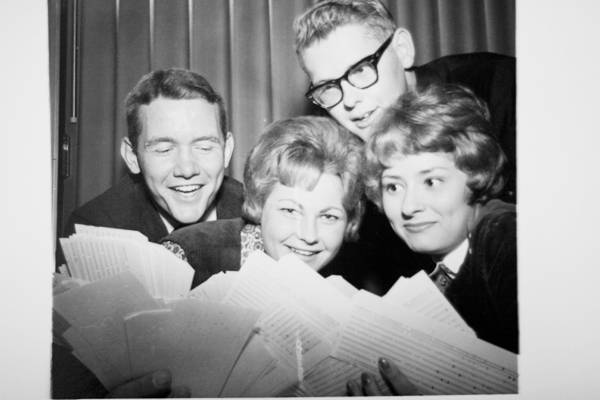IBM computer dances in the ’60s

ISU students hold results from a computer dating program in the 1960s. The system analyzed traits and matched students accordingly. Photo Courtesy: Parks Library, special collections department
May 2, 2009
owa State is home not only to the computer but possibly also to computer dating.
During the fall semester of 1963, students held a computer dance, known as the IBM dance. Students filled out a questionnaire that went through a computer sorting system to pair them with potential matches.
Edwin Lewis, retired associate provost, composed the personality questionnaire for the dance.
“I got into it because I was a psychology professor and I was part-time in Student Counseling Services,” Lewis said.
Lewis did the work on a voluntary basis and based the questionnaire off of personality inventory used at the Student Counseling Center. C.C. Mosier, operations manager of Iowa State’s Computer Center at the time, handled the computer aspect of the project.
The residence hall group, the Ward System, got the idea for the computer dance and planning for it began in the fall semester of 1963, Lewis said.
“The idea of the dance was a way to get men and women students together so they’d have something to talk about,” Lewis said. “The main value it did give the couples when they first got together [was] why did they pair us up?”
Components of the questionnaire included traits in personality, physicality and height. One important variable was that the men were to be “at least two inches taller” than the women.
“You have to remember this was over 40 years ago,” Lewis said. “Back then it seemed to make sense.”
The questionnaires attempted to connect people who would complement eachother. For example, Lewis said, “matching an outgoing person with a shy person.”
The questionnaire had 30 to 40 questions.
The cards were then put in the computer’s sorter, and the computer would sort out the most likely matches.
Although the computer did the matching, it was slow and at times it wouldn’t match men and women up if the man wasn’t two inches taller than the woman.
“We ended up with a number of people, both men and women, [who] didn’t match with other people easily,” Lewis said.
The night before the dance, Lewis and his team hand-matched these pairs until after midnight in the stat lab in Snedecor Hall.
“It was time consuming, it took us a good part of the night,” Lewis said. “Now it would take probably a half hour.”
The dance took place in the Great Hall of the Memorial Union. At the dance each person got a card with three sets of potential matches. The women would go to a certain place in the room with a number and the men looked for their match. The matches would meet for approximately a half hour each.
At the time “Iowa State had a much higher percentage of men than women” Lewis said, and since they were matching for heterosexual couples, women from nursing schools in Des Moines were asked to participate.
Lewis said the dance went well and “maybe as much as 400 or 500” people attended.
Lewis is not aware of a couple who met through the IBM dance that are still together, but he wouldn’t be surprised if a couple were, since the event was so big, Lewis said.
“I think a number of the people did connect with someone that night,” Lewis said.
The dance brought media attention to Iowa State.
“I do know we got a bit of national publicity for this,” Lewis said.
A reporter and photographer from Life magazine, Lewis said, covered the dance for their regular feature, “Life goes to…”
The feature was going to run the week of Thanksgiving, though the assassination of President John F. Kennedy occurred and “the whole magazine was devoted to the assassination.”
Time Magazine also covered the dance and featured a brief article of it, as well as other newspapers.
The popularity of Iowa State’s event led other schools to ask for instructions for the personality questionnaire.
Lewis said the computer dance was popular and newsworthy because of the computer aspect of it.
People wondered, he said, if this was how couples would be matched in the future, plus it made people more aware of the future.
Looking back, Lewis wishes he had the foresight into the future of computer dating to make money.
Although the computers are more sophisticated now, Lewis said the process of matching people as they did then is not too different from Internet dating sites such as Match.com.
“The computers can only do what the input tells them to do,” Lewis said.
More about the dances
Because the dances were student-run, they continued for a few years, said Edwin Lewis, retired associate provost, former psychology professor and member of the Student Counseling Service.
According to Iowa State’s 1967 yearbook, the Bomb, an IBM dance was held and sponsored by the Student Union Board and the Ward System.
“Pay a buck, fill out a questionnaire and find your ‘perfect’ match,” one article said. The article reminded readers the dance was “not a situation in which one is guaranteed to find a spouse, but merely what might be termed an ‘ideal session.’”
















